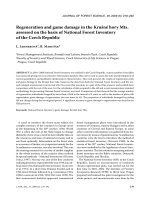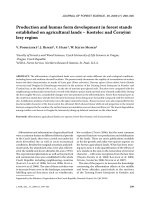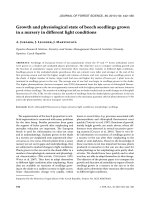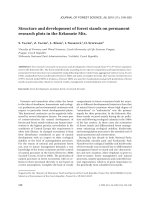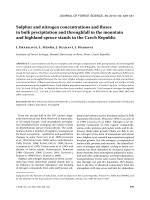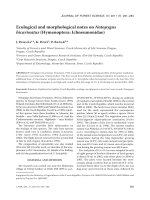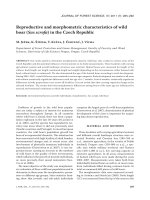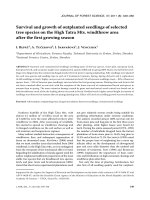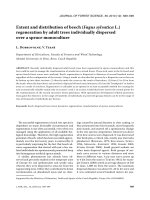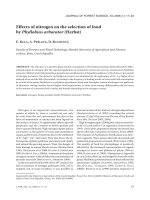Báo cáo lâm nghiệp: "Sulphur and nitrogen concentrations and fluxes in bulk precipitation and throughfall in the mountain and highland spruce stands in the Czech Republic" docx
Bạn đang xem bản rút gọn của tài liệu. Xem và tải ngay bản đầy đủ của tài liệu tại đây (223.74 KB, 13 trang )
J. FOR. SCI., 56, 2010 (10): 429–441 429
JOURNAL OF FOREST SCIENCE, 56, 2010 (10): 429–441
Supported by the Ministry of Education, Youth and Sports of the Czech Republic, Project No. MSM 6215648902, and
by the Ministry of the Environment of the Czech Republic, Project No. MŽP SP/2e3/172/07.
Sulphur and nitrogen concentrations and fl uxes
in bulk precipitation and throughfall in the mountain
and highland spruce stands in the Czech Republic
I. D, L. M, J. K, I. M
Institute of Forest Ecology, Mendel University in Brno, Brno, Czech Republic
ABSTRACT: Concentrations and fluxes of sulphur and nitrogen compounds in bulk precipitation and in throughfall
were evaluated and compared for two experimental sites in the Czech Republic: one situated at Rájec (Drahanská up-
land, 610 m a.s.l.) and the second one at Bílý Kříž (Moravian-Silesian Beskids, 908 m a.s.l.) both with similar stands of
young Norway spruce. The three-year study performed during 2006–2008, revealed statistically significant differences
in nitrate nitrogen concentrations in bulk precipitations and in ammonium nitrogen concentrations both in bulk pre-
cipitation and in throughfall between the two sites. Higher nitrogen compounds concentrations in bulk precipitation
were found at Rájec. Differences between the two sites in sulphur concentrations were not found out neither in bulk
precipitation nor in throughfall waters. Total sulphur deposition amounted to 8.1, 8.3 and 6.7 kg S·ha
–1
at Rájec and to
14.8, 16.9 and 15.4 kg S·ha
–1
at Beskids for the three years studied, respectively. Total inorganic nitrogen throughfall
flux amounted to 12.1, 11.6 and 11.6 at Rájec and 13.8, 18.9 and 15.0 kg·ha
–1
at Bílý Kříž for the years 2006, 2007 and
2008, respectively.
Keywords: Bílý Kříž (Moravian-Silesian Beskids Mts.); Czech Republic; nitrogen deposition; rainfall; Rájec (Drahanská
Highland); sulphur deposition; throughfall
From the second half of the 20
th
century large-
scale forest decay has been observed in many plac-
es of central Europe. Acid atmospheric precipita-
tion destabilized the ecological site valence mainly
of allochthonous spruce monocultures. e acidi-
fi cation shows a number of negative consequences
for forest ecosystems – qualitative and quantitative
changes in water (S et al. 1989; J
et al. 1991; K 1994) and in soils (B
1985; P 1986; E, H 1990; F-
et al. 1995; U et al. 1995) and
decline of forest stands (A, P
1988; G 1989; U 1991; B,
F 1998; P, F 2004).
Sulphur and nitrogen deposition in forest ecosys-
tems have been intensively studied mainly due to
its infl uence on nutrient imbalances and leaching
of nitrogen compounds from soils and because sul-
phates and nitrates are the dominant anions in bulk
deposition (N, W 1995; C et
al. 1999; L et al. 2007). Nitrogen is an im-
portant component of vital organic compounds,
amino-acids, proteins and nucleic acids, and its de-
fi ciency limits plant growth. Plants are able to uti-
lize nitrogen in the form of ammonium and nitrate
ions. Sulphur is an essential macronutrient required
for plant growth. It is, like nitrogen, a component of
amino acids, proteins and enzymes. e natural bal-
ance of nitrogen and sulphur cycling in forest eco-
systems has been disturbed by increased inputs of
those elements from atmosphere polluted by indus-
trial and other anthropogenic activities (agriculture,
transportation). Forest soils receive these elements
also through wet and dry deposition. Wet deposi-
tion is the fl ux of dissolved components from the
atmosphere with rain, snow and hail, dry deposition
430 J. FOR. SCI., 56, 2010 (10): 429–441
is fl ux of gases and particles from the atmosphere
during dry periods, due to gravity (sedimentation),
impaction, diff usion and other processes. Dry depo-
sition fl uxes are strongly infl uenced by the type of
surfaces (leaves, needles, rocks, and water), humid-
ity of surfaces, macro- and micrometeorology (sto-
mata closure) (UN-ECE 2006).
Sulphur and nitrogen are markedly captured by
the canopy and coniferous forests are particularly
important in this respect because they have a high
aerodynamic roughness and a dense canopy surface
over the whole year resulting in high rates of pre-
cipitation interception and the turbulent exchange
of aerosols, particles and gases from the atmo-
sphere (A et al. 2002; M et al. 2002;
C et al. 2006; G et al. 2006).
In forest ecosystems dry deposition may contribute
to the input of these elements to the soil consid-
erably because the precipitation is being enriched
with dry deposition (D et al. 1997; S-
, Tø 1997; D et al. 1998; W
et al. 1998; N 2002; B et al. 2004; C-
et al. 2004; S et al. 2004; B et
al. 2008; B et al. 2008; S et al.
2008). roughfall waters collected under canopy
thus contain larger amounts of ions than rainfall
water collected in the nearby open areas (Y,
I 1989; S, L 1990; B, H-
1993; B, T 2001).
Although Europe has been successful in reducing
the emissions of nitrogen (E et al. 2003) and
sulphur compounds (K et al. 2002; U-
, S 2002) over the past two decades
the problem of forest soil acidifi cation still persists,
especially at localities with high emission load. One
of the most polluted areas in the Czech Republic is
situated at the borders with Poland and Slovakia is
known as “Black Triangle II” (M et al. 1996).
e Drahanská Upland, on the other hand, belongs
among the cleaner areas (B et al. 2009).
Various methods can be used to measure or esti-
mate deposition to forests. One group of methods
is based on micrometeorology (S, P
1998; W, H 2000) the other group is based
on forest stand throughfall and open plot precipita-
tion sampling ( V et al. 2001; S et al.
2008). e second approach is used for the depo-
sition monitoring within the framework of Inter-
national Co-operative Programme on Assessment
and Monitoring of Air Pollution Eff ects on Forests
(UN-ECE 2006) and is used also in this study. e
main drawback of the throughfall method is the in-
teraction between the canopy and the throughfall
water for nitrogen, protons and base cations. How-
ever, throughfall deposition can give information
on the lower limit of the true deposition of nitro-
gen and the upper limit of true deposition of base
cations other than sodium. For sodium and sulphur
the canopy uptake and leaching is considered to be
negligible and consequently the throughfall fl ux
is used to estimate the total deposition (UN-ECE
2006).
e aims of this study were:
– to compare concentrations of sulphur and nitrogen
compounds in bulk precipitation and throughfall
samples at two experimental sites with young
spruce stands in the Czech Republic, one situated
in Moravian-Silesian Beskids at an altitude of 908
m and the second one in Drahanská Upland at an
altitude of 632 m;
– to assess the total sulphur deposition within young
spruce stands for these two localities with various
levels of atmospheric pollution and compare it
with the sulphur deposition fl uxes at other sites
in the Czech Republic.
MATERIAL AND METHODS
Description of the study sites and characteristics
of the two spruce stands studied is given in Table 1.
Bulk precipitation and throughfall sampling
were carried out at both sites during 2006–2008.
For sampling throughfall in the spruce stand and
atmospheric precipitation on the open area per-
manently open polyethylene sampling vessels of
an area of 335.33 cm
2
were used (B, B
1985; N, B 1995). e vessels
were inserted into the thick-walled plastic pipes
in order to shield the samples from solar radiation
and to hold the funnels approximately 1 m above
the ground. ere were 7 collectors randomly dis-
tributed at the mountain spruce stand and 5 at the
highland spruce stand. During the winter the num-
ber of collectors at the mountain spruce stand was
reduced to 5. Bulk atmospheric precipitation was
sampled at both sites with one collector installed
in the nearby open area. Samples were taken once
a month in the winter season and in 14-day inter-
vals in other seasons. e samples were transferred
to the laboratory and prepared for the analyses
usually the next day after sampling. One propor-
tional sample was prepared from water collected in
all samplers at a particular plot. In winter it was
sometimes necessary to wait one day because the
samples were frozen. Determination of ammonia
was done immediately in freshly prepared samples;
the aliquots for sulphate and nitrate determination
J. FOR. SCI., 56, 2010 (10): 429–441 431
Table 1. Description of study sites and spruce stands
Mountain spruce stand Highland spruce stand
Study site
locality
Bílý Kříž – Moravian-Silesian
Beskids Mts.
Rájec – Drahanská Highland
geographic coordinates 49°30'N, 18°32'E 49°29'N, 16°43'E
altitude 908 m a.s.l. 610 m a.s.l.
geological subsoil
fl ysh layer
with dominant sandstone
acid granodiorite
soil characteristics
(soil type)
Typical humo-ferric
Podzol (PZhz')
1
Podzols (PZ)
2
with mor-moder form
of surface humus
Modal oligotrophic
Cambisol (KAmd')
1
Cambisols (CM)
2
with moder form
of surface humus
3
Climatic characteristics
summer days 10 to 30
4
30 to 40
4
days with mean temperature 10°C and more
120 to 140
4
140 to 160
4
days with frost 140 to 160
4
110 to 130
4
ice days 50 to 60
4
40 to 50
4
mean temperature in January –4 to –5°C
4
–2 to –3°C
4
mean temperature in April 2 to 4°C
4
6 to 7°C
4
mean temperature in July 14 to 15°C
4
16 to 17°C
4
mean temperature in October 5 to 6°C
4
7 to 8°C
4
mean number of days with
precipitation equal 1 mm and more
120 to 130
4
100 to 120
4
sum of precipitation during the vegetation
period
600 to 700 mm
4
400 to 450 mm
4
sum of precipitation during the winter
period
400 to 500 mm
4
250 to 300 mm
4
days with snow cover 120 to140
4
60–100
4
cloudy days 150 to160
4
120 to 150
4
cloudless days 40 to 50
4
40 to 50
4
mean annual precipitation total 1,115.3 (1961–1990)
7
643.4 (1957–2000)
7
mean annual temperature 4.91 (1961–1990)
7
6.95 (1961–2000)
7
Spruce stand
tree species Picea abies [L.] Karst. Picea abies [L.] Karst.
stand age (years) 2008 31 34
mean stand
height (m)
2006 11.6 NA
2007 12.2 NA
2008 12.5 15.5
stand density
(trees·ha
–1
)
2006 1,456 NA
2007 1,456 NA
2008 1,428 1,360
forest typology
5S1–Abieto-Fagetum
mesotrophicum
7
5S1–Abieto-Fagetum
mesotrophicum with
Oxalis acetosella
7
1
N et al. (2001);
2
IUSS Working Group WRB (2006);
3
M et al. (2009);
4
Q (1971);
5
H (personal com-
munication);
6
H (2002);
7
P (1987); NA – not available
were frozen and kept in freezer until analyzed (usu-
ally within a month after the sample preparation). e
methods used for determination of SO
4
2
,
–
, NO
3
–
and
NH
4
+
are listed in Table 2.
Mean amount of throughfall water was calculated
for the individual sampling term as the arithmetic
average of the water captured in the parallel col-
lectors at the given plot. Mean annual concentra-
432 J. FOR. SCI., 56, 2010 (10): 429–441
Table 2. List of methods and instruments used for the analysis of rainfall and throughfall waters
Analyte Analytical method Instrumentation
NH
4
spectrophotometric at the wave-length
of 650 nm or fl ow injection analysis
with diff usion chamber
UV/VIS spectrophotometer or fl ow injection
analyzer FIAlab 2500
NO
3
, SO
4
high performance ion exchange liquid
chromatography with gradient elution
chromatograph DX-600 DIONEX with gradient
pump GP50
tions for individual ions and plots were calculated
as weighted means (weights were precipitation
amounts) of ions concentrations measured during
the year at the particular plot. e fl uxes of SO
4
2
,
–
,
NO
3
–
and NH
4
+
(mg·m
–2
) in bulk precipitation and
in throughfall for each sampling event were calcu-
lated as a product of the amount of water (l·m
–2
)
and the relevant element concentration (mg·l
–1
)
and summed for every single year and plot to give
annual fl ux for the particular plot.
Statistical software STATISTICA 9.0 (StatSoft
2008) was used for results evaluation.
RESULTS
Water fl uxes
Bulk precipitation totals on the open area and
amounts of throughfall within spruce stands at both
study sites in 2006–2008 are shown in Fig. 1. An-
nual precipitation totals were 1,171 mm, 1,282 mm,
1,033 mm and 661, 551, 458 mm for the three years,
2006–2008, at Bílý Kříž and Rájec, respectively. e
driest year was 2008 when precipitation total at Bílý
Kříž was only 1,033 mm and at Rájec 458 mm. e
values measured at Bílý Kříž were above the long
term average (which was 1,115 mm for the period
of 1961–1990 according to Hadaš – personal com-
munication) in 2006 and 2007 and lower than the
long term average in 2008. In Rájec the precipitation
total in the fi rst year studied was above the long term
average (i.e. 643 mm for the period of 1957–2000,
H 2002), the next two years were under the long
term average from the point of view of precipitation
totals. At Bílý Kříž the amounts of throughfall were
higher by 1–4% than precipitation totals. Negative
interception was recorded also in the spruce stand
at Rájec in 2006 and 2007 (increase of throughfall
amounts by 3% and 13%, respectively), whereas in
2008 the throughfall amount was by 3% lower than
the bulk precipitation total on the open area.
Ion concentrations in bulk precipitation
and throughfall
Mean annual concentrations of sulphate, nitrate
and ammonium ions are summarized in Table 3.
Mean annual sulphate concentrations in bulk open
area (BOA) precipitation were 1.81–2.01 mg·l
–1
and
1.68–2.30 mg·l
–1
, for througfall (THR) waters the
values were 3.77–4.30 mg·l
–1
and 4.53–4.50 mg·l
–1
,
at Bílý Kříž and Rájec, respectively, and as can be
seen, the values for throughfall precipitation were
not substantially diff erent for both sites in indi-
vidual years. Mean annual nitrate concentrations
in BOA precipitation were 1.59–1.72 mg·l
–1
, and
2.08–3.49mg·l
–1
at Bílý Kříž and Rájec, respectively.
In throughfall the values were within 2.66–3.29 mg·l
–1
at Bílý Kříž and within 3.43–5.45 mg·l
–1
at Rájec
(Table 3). Mean annual ammonium concentra-
tions in BOA precipitation were 0.63–0.71 mg·l
–1
and 0.90–1.63 mg·l
–1
, for througfall the values were
0.73–0.93 mg·l
–1
and 1.23–1.84 mg·l
–1
, at Bílý Kříž
and Rájec, respectively. A substantial diff erence be-
tween the two sites in concentrations of nitrogen
compounds both in bulk precipitation and through-
fall is apparent with higher concentrations found al-
ways for waters from Rájec.
400
600
800
1,000
1,200
1,400
t
ation amount in (mm)
2006
2007
2008
0
200
400
600
800
1,000
1,200
1,400
BK BOA BK THR RAJ BOA RAJ THR
Precipitation amount in (mm)
Plot
2006
2007
2008
Fig. 1. Bulk open area precipitation (BOA) totals and
throughfall (THR) amounts within spruce stands at
Bílý Kříž (BK) and Rájec (RAJ) experimental sites in
2006–2008
J. FOR. SCI., 56, 2010 (10): 429–441 433
Table 3. Mean annual concentrations of sulphate, nitrate and ammonium ions in bulk open area (BOA) precipitation
and in throughfall (THR) within the spruce stands at the study sites in Bílý Kříž and Rájec
Sampler/
plot
SO
4
2
–
(mg·l
–1
)NO
3
–
(mg·l
–1
)NH
4
+
(mg·l
–1
)
2006 2007 2008 2006 2007 2008 2006 2007 2008
Bílý Kříž
BOA 2.01 1.97 1.81 1.72 1.59 1.61 0.63 0.71 0.65
THR 3.77 3.87 4.30 2.66 3.20 3.29 0.73 0.93 0.85
Rájec
BOA 1.68 2.30 2.14 2.08 3.49 3.09 1.31 0.90 1.64
THR 3.53 3.97 4.50 3.43 3.99 5.45 1.28 1.23 1.84
e relative increase of annual element fl uxes in throughfall when compared with bulk precipitation in (%)
Bílý Kříž
88 97 138 55 101 105 16 31 31
Rájec
110 73 110 65 14 76 –2 36 12
A 2-way ANOVA was performed to test the sig-
nifi cance of plot (Bílý Kříž open area, Bílý Kříž
throughfall, Rájec open area and Rájec throughfall)
and year (2006, 2007, 2008) infl uence on sulphate,
nitrate and ammonium concentrations in precipi-
tation. e results obtained are shown in the Fig.2.
e concentrations of sulphates and nitrates did
not diff er signifi cantly between 2006 and 2007. Sig-
nifi cantly higher concentrations of sulphate and
nitrate were found in 2008 than in 2006 and 2007
what is probably related to the lowest amount of
precipitation in 2008 (Fig. 2). Ammonium concen-
trations were also higher in 2008 than in the two
previous years but the diff erence was not statisti-
caly signifi cant. It is also evident that there was no
signifi cant diff erence in sulphate concentrations
between the two study sites, neither between S-SO
4
concentrations in bulk open area precipitation, nor
in S-SO
4
concentrations in throughfall (Fig. 2a). For
nitrogen compounds (nitrate and ammonium), on
the other hand, the results indicate signifi cant dif-
ferences between the two sites in bulk open fi eld
concentrations and in case of ammonium also in
througfall concentrations, with higher values hav-
ing been found at Rájec (Figs. 2c, e). Signifi cantly
higher (P<10
–4
) at both sites were sulphate con-
centrations in throughfall within spruce stands
than in bulk open area precipitation (Figs. 2a, c).
e relative diff erences between the element
concentrations in bulk precipitation and through-
fall are shown in the lower part of the Table 3. For
sulphate ions the relative increase of concentration
in throughfall (calculated as) was about 100% at
both study sites during the three years studied. e
relative increases of mean annual nitrate concen-
trations in throughfall in individual years were a bit
lower at the both sites when compared with sul-
phate, namely: 55, 101, 105% and 65, 14 and 76% for
Bílý Kříž and Rájec, respectively during the three
consecutive years (Table 3). e lowest concen-
tration increase was observed for ammonium. In
2006 in Rájec the mean ammonium concentration
in throughfall was even lower than the ammonium
concentration in BOA precipitation.
Element fl uxes in precipitation and throughfall
Annual bulk and throughfall fl uxes of sulphur and
nitrogen are depicted in the Fig. 3 with numerical val-
ues given in Table 4. Sulphur fl uxes were markedly
higher at Bílý Kříž than at Rájec both in the open area
and in the throughfall in all years studied. e same
holds for the fl uxes of nitrate nitrogen in throughfall
and in BOA precipitation (Fig. 3b). As concerns am-
monium nitrogen, the fl uxes were also higher at Bílý
Kříž with some exceptions which occurred in 2006
(both BOA and throughfall fl ux was higher at Rájec)
and in 2008 (BOA fl ux was higher at Rájec).
e throughfall fl uxes of sulphur were, when
considering the three years average, 2.1 times high-
er than open area fl uxes at both study sites (see
lower part of Table 4). e throughfall fl uxes of ni-
trate were 1.9 times higher than open fi eld fl uxes
at Bílý Kříž but only 1.6 times higher at Rájec (the
values are three years averages). e throughfall
fl uxes of ammonium at Bílý Kříž were 1.3 times
higher than open fi eld fl uxes. At Rájec the through-
fall fl uxes of ammonium were almost the same as
the fl uxes with BOA precipitation in all years but
2007 when the throughfall fl ux was about 1.2 times
higher than open fi eld fl ux. From the three years
comparison of the two localities is evident that the
soils under the spruce stand at Bílý Kříž received
annually about 15.7 kg S·ha
–1
while soils at Rájec
only 11.9 kg S·ha
–1
what makes diff erence of about
4 kg sulphur per ha and year. In case of sulphur the
throughfall fl uxes can serve as a good estimate of
434 J. FOR. SCI., 56, 2010 (10): 429–441
Fig 2. Results of two-way ANOVA analysis of sulphate, nitrate and ammonium concentrations measured in precipita-
tion and throughfall at Bílý Kříž and Rájec study sites during 2006–2008
(b)
(c)
(a)
(d)
(e)
(f)
BK BOA BK THR RAJ BOA RAJ THR
S-SO
4
N-NO
3
N-NH
4
S-SO
4
N-NO
3
N-NH
4
S-SO
4
N-NO
3
N-NH
4
S-SO
4
N-NO
3
N-NH
4
BK BOA – – –
** **
NS NS
** ** ** ** **
BK THR
** **
NS –––
**
NS
*
NS NS
*
RAJ BOA NS
** ** **
NS
*
–––
** *
NS
RAJ THR
** ** **
NS NS
****
NS – – –
2006 2007 2008
S-SO
4
N-NO
3
N-NH
4
S-SO
4
N-NO
3
N-NH
4
S-SO
4
N-NO
3
N-NH
4
2006
–– – NSNSNS
***
NS
2007 NS NS NS – – –
**
NS
2008
*
** NS
**
NS – – –
BOA – bulk open area precipitation, THR –
throughfall, NS – not signifi cant, *P < 0.05, **P < 0.01 (Scheff é’s post-hoc tests)
J. FOR. SCI., 56, 2010 (10): 429–441 435
Table 4. Annual element fl uxes at Rájec and Bílý Kříž experimental study sites during 2006–2008 with open area
(BOA) precipitation and with throughfall (THR)
Sampler/ plot
S-SO
4
2
–
(kg·ha
–1
)N-NO
3
–
(kg·ha
–1
)N-NH
4
+
(kg·ha
–1
)N
inorg
(kg·ha
–1
)
2006 2007 2008 2006 2007 2008 2006 2007 2008 2006 2007 2008
BOA – Bílý Kříž 7.8 8.4 6.2 4.5 4.6 3.7 5.7 7.0 5.2 10.3 11.6 8.9
THR – Bílý Kříž 14.8 16.9 15.4 7.1 9.5 7.9 6.7 9.5 7.0 13.8 18.9 15.0
BOA –Rájec
3.7 4.2 3.3 3.1 4.3 3.2 6.7 3.9 5.8 9.8 8.2 9.0
THR – Rájec 8.1 8.3 6.7 5.3 5.6 5.5 6.8 6.0 6.4 12.1 11.6 11.9
e relative increase of annual element fl uxes in throughfall when compared with bulk precipitation in%:
(100% × THR/BOA) – 100
Bílý Kříž 89 101 146 56 106 112 17 34 36 34 63 68
Rájec
117 96 105 70 29 72
1 55 9 23 41 31
total sulphur deposition (UN-ECE 2006). e an-
nual input of inorganic nitrogen into the soil was
also higher at Bílý Kříž with the average annual val-
ue of 15.9 kg·ha
–1
. In Rájec the average annual value
was about 11.9kg·ha
–1
.
DISCUSSION
Water fl uxes
e negative values of interception could be ex-
plained by higher contribution of occult precipita-
tion (fog and dew) to the throughfall at localities
with more fog days. According to the T (2007)
the average annual number of days with fog exceeds
150 at the locality of Bílý Kříž. e contribution of
fog as a water source to the water budget of forest
ecosystems is documented by Z et al.
(1999). T et al. (2002) have shown that the con-
tribution of condensed fog water to the amount of
bulk precipitation was about 9% in a catchment in
the Šumava Mts. in the course of 1994–2000. S-
(2006) found that 22% of throughfall amounts
came from occult precipitation in 2003–2004 in a
spruce stand at Lysá hora mountain (1,324 m a.s.l.)
in Beskids only 9 km from our experimental site.
Ion concentrations in bulk precipitation
and throughfall
e concentrations of nitrogen and sulphur in
bulk precipitation evaluated in this study (Table3)
were compared with values measured at the same
sites in the past. K et al. (1996) evaluated the
mean annual concentrations of sulphate and ni-
trate in bulk precipitation in Rájec for the period of
1976–1990. Average sulphate and nitrate concentra-
tions in bulk precipitation were then 16.8mg·l
–1
and
7.1 mg·l
–1
, respectively. e distinct drop of average
sulphate and nitrate concentrations to 2.0mg·l
–1
and
2.9 mg·l
–1
, respectively, found for 2006–2008 in our
study corresponds well with the reduction of total
emission of SO
2
and NO
x
in the Czech Republic
within the course of 1980–2000. In 2000 the sulphur
dioxide and NO
x
emissions, were 8 times and 2.4
Fig 3. Annual deposition of sulphur (a) and nitrogen (b) at Bílý Kříž and Rájec study sites calculated for the years
2006–2008. Upper empty parts of bars in the second chart denote ammonium nitrogen; lower full parts of the bars
denote nitrate nitrogen
(a) (b)
436 J. FOR. SCI., 56, 2010 (10): 429–441
times respectively, lower than those in 1980 accord-
ing to H and C (2002), K
and V (2005) and M et al. (2005). K-
et al. (2001) evaluated element concentrations
in bulk precipitation at the Bílý Kříž site for the year
1999: the sulphate and nitrate concentrations were
2.9 mg·l
–1
and 2.2 mg·l
–1
, respectively. e corre-
sponding values found in our study were 1.9 mg·l
–1
and 1.6 mg·l
–1
, respectively, which again agree with
a 20–30% decrease of SO
2
concentrations in the air
in the Czech Republic between 1999 and 2007 (MŽP
2008). e decrease in nitrate concentration at Bílý
Kříž between 1999 and years of this study can only
partly be explained from the overall decrease (12%
between 199 and 2007 according to MŽP 2008) of
NO
x
concentrations in the air in the Czech Republic.
Nitrogen oxides in general have a shorter lifespan in
the lower atmosphere and their concentrations are
more likely to be infl uenced by local sources of pol-
lution in shorter time horizons.
Annual mean concentrations of sulphates, nitrates
and ammonium in bulk open area precipitation
measured at Rájec and Bílý Kříž fi t in the range of
values measured on higher elevated sites throughout
the Europe as is apparent from the Table 5.
e 100% relative increase of sulphate con-
centration in throughfall vs BOA precipitation
found for our study sites (Table 3) can be com-
pared with the data published by K et al.
(2009) for the four mature (150 years old) spruce
stands in the Bohemian Forest. At the altitudes of
1,000–1,330m a.s.l. for the period 1998–2007 the
relative increase of sulphur concentrations under
the crowns was 50–100%. B et al. (2008)
study of a 65 years old spruce stand near Kreisbach
(Austria) found a 129% relative increase of sulphur
concentration under the crowns. Sulphate is a con-
servative anion which means it is neither taken up
by canopy nor leached from the foliage ( V et
al. 2001; B et al. 2007) or, more precisely
said, the minor stomatal uptake of SO
2
is balanced
by minute leaching of SO
4
2
–
from needles (C et
al. 1992; D et al. 1996). e increase of
sulphate concentration in throughfall can be fully
assigned to the washing of dry deposites accumu-
lated on the canopy between precipitation events.
At both study sites the conditions infl uencing dry
deposition (stand age, structure and composition,
content of sulphur compounds in the air, humidity
conditions) are similar and thus we found a similar
increase of sulphate concentrations in throughfall.
While in case of sulphate, the concentrations in
BOA precipitation were not signifi cantly diff erent
at the two study sites, signifi cantly higher concen-
trations of nitrate and ammonium were found in
BOA precipitation at Rájec than at Bílý Kříž. is
can be explained by the diff erent character of the
two study sites. e spruce stand in Rájec is embe-
ded into agricultural landscape with three villages
within the distance of 1.5 km from the stand and
two local minor roads within 0.5 km. e spruce
stand in Bílý Kříž is quite detached in a mountain-
ous region. Agriculture, especially livestock pro-
duction, is the dominant source of atmospheric
NH
4
(A et al. 2001; EKL 2005; E 2007;
MŽP 2008 and also contributes signifi cantly to
nitrogen oxides emissions. e combustion of fos-
sil fuels (i.e. transport and industry) produces the
main part of atmospheric nitrogen oxides. From
this point of view, the lower concentrations of am-
monia nitrogen at Bílý Kříž are understandable.
e biogeochemical behavior of inorganic N in
canopy diff ers both between the sites and between
the reduced and oxidized form of nitrogen. While
nitrate concentrations were signifi cantly higher in
throughfall vs BOA precipitations at both sites,
only insignifi cant increases in throughfall concen-
trations were observed for ammonium. It suggests
assimilation of NH
4
+
by canopy foliage. NH
4
–N re-
tention in coniferous forest canopy was described
e.g. by P et al. (1998) and H et al.
(1999). Spruce canopies have been shown to be ac-
tive sinks for inorganic N, and to have the highest
biomass of epiphytic lichens (capable to assimilate
nitrogen compounds) compared to pine and decid-
uous canopies (L 1992; H et al. 1999).
e higher effi ciency of the spruce forest in Rájec
in retaining nitrogen which (see ANOVA results
Figs. 2c, e) could be explained by more favorable
climatic conditions in Rájec which support meta-
bolic activities of the microorganisms assimilating
nitrogen compounds.
Element fl uxes in precipitation and throughfall
In case of sulphur the throughfall fl uxes can serve
as a good estimate of total sulphur deposition (
V et al. 2001). e total sulphur deposition
was greater at Bílý Kříž (due to higher throughfall
amounts (Table 4), because throughfall concentra-
tions were similar at the both plots. Also, the BOA
and throughfall fl uxes of N-NO
3
were higher at Bílý
Kříž in all years studied despite the fact that cor-
responding concentrations were higher at Rájec
during the whole period. e throughfall fl uxes of
sulphur were 2.0 to 2.4 times higher than open area
fl uxes at both study sites (see lower part of Table4).
ese values are in accordance with values pub-
lished by other authors. A et al. (2002) re-
J. FOR. SCI., 56, 2010 (10): 429–441 437
viewed several papers bringing data from European
forest sites and found that atmospheric deposition
of sulphur had been 2 to 3 times higher in stands of
Picea abies or Pinus sylvestris than in open areas.
e element fl uxes at Bílý Kříž and Rájec were
compared with bulk open area and throughfall fl ux-
es measured in other parts of the Czech Republic at
experimental plots with deposition measurement
included in the ICP-Forests monitoring programme.
e data from 12 localities, where deposition
monitoring had been performed during for 2006–
2007 were recently published in the annual report
(B et al. 2009). e ICP intensive monitor-
ing plots (level II plots) were installed in 1994–2004
to cover main tree species in their typical regions of
the Czech Republic. It can be seen that the locality
of Bílý Kříž belongs to the sites with higher sulphur
fl ux with both bulk precipitation and throughfall.
Higher sulphur fl uxes in the open fi eld were mea-
sured in 2006 and 2007 at Jizerka in Jizerské Mts.
(9.70 and 14.28 kg S·ha
–1
·a
–1
), Mísečky in Krkonoše
Mts. (10.11 and 12.62 kg S·ha
–1
·a
–1
), and in 2006 also
at Klepačka in Beskids (10.21kgS·ha
–1
·a
–1
). Higher
sulphur fl uxes with throughfall were registered in
2006 and 2007 at Jizerka (21.32 and 27.13 kg S·ha
–
1
·a
–1
), at Luisino údolí in Orlické Mts (34.49 and
34.13 kg S·ha
–1
·a
–1
) and at Klepačka only in 2006
(20.97 kg S·ha
–1
·a
–1
) (all data from B et
al. 2009). Norway spruce is the main species in all
stands with these high sulphur throughfall fl uxes
what affi rms the higher fi ltering capacity of spruce
canopy (H et al. 2009). Nitrogen fl uxes at Bílý
Kříž are neither low nor high when compared with
the ICP plots. Rájec belongs in the Czech Repub-
lic to the localities with lower load of sulphur and
nitrogen.
Table 5. Annual element concentrations in bulk open fi eld precipitation measured at various mountainous regions
in Europe in comparison with values measured at Bílý Kříž and Rájec
Concentration Country (locality)
SO
4
2
–
(mg·l
–1
)
1.81–2.01 Bílý Kříž (Czech Republic)
1
1.68–2.30 Rájec (Czech Republic)
2
0.81–1.21 Czech Republic
3
0.98–1.44 Czech Republic
4
1.59–3.99 Germany
5
1.69–4.57 Germany
6
3.50–4.52 Switzerland
7
3.82 (fi ve-year average) Poland
8
NO
3
–
(mg·l
–1
)
1.59–1.72 Bílý Kříž (Czech Republic)
1
2.08–3.49 Rájec (Czech Republic)
2
1.42–1.59 Czech Republic
3
1.54–1.95 Czech Republic
4
1.12–2.63 Germany
5
1.56–2.64 Germany
6
2.39–3.06 Switzerland
7
3.72 (fi ve-year average) Poland
8
NH
4
+
(mg·l
–1
)
0.63–0.71 Bílý Kříž (Czech Republic)
1
0.90–1.64 Rájec (Czech Republic)
2
0.39–0.51 Czech Republic
3
0.44–0.58 Czech Republic
4
0.41–1.00 Germany
5
0.63–1.23 Germany
6
0.72–1.06 Switzerland
7
1.47 (fi ve-year average) Poland
8
1
Bílý Kříž (Moravian-Silesian Beskids Mts.), 908 m a.s.l., 2006–2008;
2
Rájec (Drahanská upland), 610 m a.s.l., 2006–2008;
3
Bohemian Forest, 1,080 m a.s.l., 1998–2007 (K et al. 2009);
4
Bohemian Forest, 1,180 m a.s.l., 1998–2007 (K
et al. 2009);
5
Erzgebirge – Oberbärenburg, 735 m a.s.l., 1993–2002 (Z et al. 2006);
6
Erzgebirge – Zinnwald,
877ma.s.l., 1993–2002 (Z et al. 2006);
7
Southern Alps - Novaggio, 950 m a.s.l., 1997–2001 (T et al.
2005);
8
8
Dupniański Stream Catchment – Silesian Beskid Mts., 725 m a.s.l., 1999–2003 (
Dupniański Stream Catchment – Silesian Beskid Mts., 725 m a.s.l., 1999–2003 (
M
M
,
,
A
A
2005)
2005)
438 J. FOR. SCI., 56, 2010 (10): 429–441
CONCLUSION
e comparative study of sulphur and nitrogen
compounds concentrations in atmospheric pre-
cipitation and throughfall at two forest sites with
young spruce monoculture in the Czech Republic
has revealed some diff erences between the two
sampling areas. While the diff erences between the
sites in sulphate concentrations were not signifi -
cant neither in bulk open area precipitation nor in
throughfall, signifi cant diff erences were observed
in ammonium nitrogen and nitrate nitrogen con-
centrations. e concentrations of ammonium ni-
trogen were signifi cantly higher at Rájec than at
Bílý Kříž both in open area bulk precipitation and
in throughfall. Concentrations of nitrate nitrogen
were signifi cantly higher in bulk open area precipi-
tation at Rájec than at Bílý Kříž. e througfall ni-
trate concentrations were also higher at Rájec but
the diff erence was evaluated as non signifi cant on
the signifi cance level of 0.05. Higher concentra-
tions of nitrogen compounds in precipitations at
Rájec can be explained by the infl uence of local ag-
riculture and traffi c on atmospheric pollution. e
spruce canopy at the Rájec stand retained nitrogen
more effi ciently than that at Beskids.
Sulphur fl uxes in the years 2006–2008 were
markedly higher at Bílý Kříž than at Rájec both
in the open area (6.2–8.4 kg S·ha
–1
·a
–1
at Bílý
Kříž vs 3.3–4.2 kg S·ha
–1
·a
–1
at Rájec) and in the
throughfall (14.8–16.9 kg S·ha
–1
·a
–1
at Bílý Kříž vs
6.7–8.3kg S·ha
–1
·a
–1
at Rájec). e locality of Bílý
Kříž belongs to the sites in the Czech Republic with
higher sulphur deposition load with both bulk pre-
cipitation and throughfall. It could be caused by the
fact that the NW wind fl owing mainly in January
and February brings to this site air polluting sub-
stances from the Ostrava industrial agglomeration.
Aknowledgements
e authors would like to thank S. Š,
S. T, H. L, M. R and L.
J for sample handling and dedicated work in
the fi eld and in the laboratory and K. J for
language revision.
References
A F., P T. (1988): Liming as a counter-
measure against acidifi cation in terrestrial environments.
Acidifi cation Research in Sweden, 7: 5–7.
A V. P., R P. A., M G. C., S J.,
E J. W., F D., A W.A.H., P N. (2001):
Atmospheric nitrogen compounds II: Emissions, transport,
transformation, deposition and assessment. Atmospheric
Environment, 35: 1903–1911.
A L., R J., B D., R A. (2002):
Impact of several common tree species of European tem-
perate forests on soil fertility. Annals of Forest Science,
59: 233–253.
B R., T A. (2001): Atmospheric deposition
and canopy exchange processes in alpine forest ecosystems
(northern Italy). Atmospheric Environment, 35: 6421–6433.
B R., A S., B M.C., M R.,
R, M., T A. (2007): Dry deposition of
particles and canopy exchange: Comparison of wet, bulk
and throughfall deposition at fi ve forest sites in Italy. At-
mospheric Environment, 41: 745–756.
B S., G F., B P. (2008): Infl uence
of tree species on understory vegetation diversity and
mechanisms involved – A critical review for temperate and
boreal forests. Forest Ecology and Management, 254: 1–15.
B C., H K., G P. (1993): Spatial variabil-
ity of throughfall fl uxes in a spruce forest. Environmental
Pollution, 81: 257–267.
B N., P D., C F. (2004): Regression
equations for estimating throughfall nutrient fl uxes using
wet deposition data and their applicability for simulat-
ing the soil acid-base status using the dynamic forest
soil-atmosphere model SAFE. Ecological Modelling, 175:
151–167.
B T.W., U H., S H., J G. (2008):
roughfall fl uxes in a secondary spruce (Picea abies), a
beech (Fagus sylvatica) and a mixed spruce-beech stand.
Forest Ecology and Management, 255: 605–618.
B J., B U. (1984): Ergebnisse der Schadstoff depo-
sitionsmessungen in Waldökosystemen in den Messjahren
1981/82 und 1982/83. Forschung und Beratung, Reihe C,
Heft 39. Münster, Landwirtschaftsverlag: 1–296. (in German)
B L., B V., Č M., F P., F-
V., L Z., L B., Š V.,
U H., V L. (2009): Forest Condition Mo-
nitoring in the Czech Republic. [Annual report ICP Forests/
Forest Focus 2006 and 2007.] Jíloviště-Strnady, VÚLHM: 134.
B K.A. (1985): Acid deposition: Eff ects of sulphuric acid
at pH 3 on chemical and biochemical properties of bracken
litter. Soil Biology & Biochemistry, 17: 31–38.
B F., F, M. (1998): Air pollution, forest con-
dition and forest decline in Southern Europe: an overview.
Environmental Pollution, 101: 49–65.
C J., B E., W M., M D., B R.,
W W., S H. (1999): Atmospheric
nitrogen deposition at a conifer forest: response of free
amino acids in Engelmann spruce needles. Environmental
Pollution, 105: 79–89.
C J.N., S L.J., F D., H A.F.,
P J.A., D P. (1992): Contribution of canopy
J. FOR. SCI., 56, 2010 (10): 429–441 439
leaching to sulphate deposition in a Scots pine forest.
Environmental Pollution, 75: 229–236.
C M., C A., S L.J., S H.,
C J.N. (2004): roughfall chemistry and canopy inter-
actions in a Sitka spruce plantation sprayed with six dif-
ferent simulated polluted mist treatments. Environmental
Pollution, 127: 57–64.
C J.R., E B., J P. E. (2006):
Modelling water balance and nitrate leaching in temperate
Norway spruce and beech forests located on the same soil
type with the CoupModel. Forest Ecology and Manage-
ment, 237: 545–556.
D V W., R G.J., V S C., D
G.P. J., B A., E J.W., A J., G
P., K H.L., V D H., D Z D.,
D J., V J.C.H., V E.M. (2001): Intensive
Monitoring of Forest Ecosystems in Europe. [Technical
Report.] Brussel, Geneva, UN/ECE and EC, Forest Inten-
sive Monitoring Coordinating Institute: 177.
D N.B., M E., G P. (1998): Synthesis of
nitrogen pools and fl uxes from European forest ecosystems.
Water, Air and Soil Pollution, 105: 143–154.
D G.P.J., E J.W., S T., W G.P.
(1996). e application of throughfall measurements for
atmospheric deposition monitoring. Atmospheric Environ-
ment, 30: 3349–3361.
D G.P.J., E J.W., V L N.F.M.,
R F.G., D W B.H., V A.C., V-
A.T., W G.P. (1997): e impact of canopy
exchange on diff erences observed between atmospheric
deposition and throughfall fl uxes. Atmospheric Environ-
ment, 31: 387–397.
EKL (2005): Stickstoff haltige Luftschadstoff e in der Schweiz.
StatusBericht der Eidgenössische Kommission für Luft-
hygiene EKL. Schriftenreihe Umwelt Nr. 384. Bern, Bun-
desamt für Umwelt, Wald und Landschaft BUWAL: 168.
E J.W., G P., S M. (2003): e Eu-
ropean perspective on nitrogen emission and deposition.
Environmental International, 29: 311–325.
E J.W., B A., G J., S M.S.
(2007): Reduced nitrogen in ecology and the environment.
Environmental Pollution, 150: 140–149.
E F.H., Hü R.F. (1990): A new fertilization strategy in
declining forests. Water Air and Soil Pollution, 54: 495–508.
F A.J., Z D.A., H F.M. (1995):
Comparison of microbiological methods for evaluating
quality and fertility of soil. Biology and Fertility of Soils,
19: 135–140.
G E. (1989: Scientifi c understanding of ecosystem
acidifi cation – a historical review. AMBIO, 18: 150–154.
G P., S I.K., R-R K.
(2006): Leaching of nitrate from temperate forests – eff ect
of air pollution and forest management. Environmental
Reviews, 14: 1–57.
H P. (2002): Temperature and precipitation conditions
in the high elevation spruce stands of the Drahanská vr-
chovina upland. Ekológia, 21: 69–87.
H S., H-T A., L N. (2009):
Canopy composition as a measure to identify patterns of
nutrient input in a mixed European beech and Norway
spruce forest in central Europe. European Journal of Forest
Research, 128: 13–25.
H D., O R., P R., L J.G. (1999):
Interactions of atmospheric deposition with a mixed
hardwood and a coniferous forest canopy at the Lake Clair
Watershed (Duchesnay, Quebec). Canadian Journal of For-
est Research, 29: 1935–1943.
H J., C E. 2002: Long-Term Forest Soil Acidi-
fi cation and Nutrient Degradation-Limitation to Contem-
porary Forestry. Praha, MŽP: 159. (in Czech.)
IUSS Working Group WRB (2006): World reference base for
soil resources 2006. 2
nd
Ed. World Soil Resources Reports
No. 103. Rome, FAO.
J D.W., C M.S., N S.I., T J.,
U B., B D., C D.W. (1991): Soil changes
in forest ecosystems: Evidence for and probable causes.
Proceedings of the Royal Society of Edinburgh SectionB –
Biological Sciences, 97: 81–116.
K E., K J., V D. 1996): Changes in the
quality of precipitation water passing through a Norway
spruce forest ecosystem in the agricultural-forest landscape
of the Drahanská vrchovina uplands. Ekológia, 15: 295–306.
K J., V J. (2005): Sulfur and nitrogen emissions
in the Czech Republic and Slovakia from 1850 till 2000.
Atmospheric Environment, 39: 2179–2188.
K J., T J., H J., Š H. (2009):
Canopy leaching of nutrients and metals in a mountain
spruce forest. Atmospheric Environment, 43: 5443–5453.
K K. (1994): e infl uence of catchment processes
in forests on the recovery in fresh waters. In: S
C.E.W., W R.F. (eds): Acidifi cation of Freshwater
Ecosystems: Implications for the Future. New York, John
Wiley: 325–344.
K J., B M., F P. 2001: A con-
tribution to the knowledge of resilience of forest ecosys-
tems at higher altitudes of the Moravian-Silesian Beskids
Ekológia, 20 (Supplement 1): 15–35.
K H., S S., C N., T T., A D.
(2002): Time series study of concentrations of SO
4
2
–
and H
+
in precipitation and soil waters in Norway. Environmental
Pollution, 117: 215–224.
L A., A G.I., H R., L H.
(2007): Nitrogen budgets for Scots pine and Norway spruce
ecosystems 12 and 7 years after the end of long-term ferti-
lization. Forest Ecology and Management, 238: 130–140.
L G.M. (1992): Atmospheric Deposition and Forest
Nutrient Cycling. In: J D.W., L S.E. (eds):
Ecological Studies 91. Berlin, Springer-Verlag: 152–166.
440 J. FOR. SCI., 56, 2010 (10): 429–441
M S., A A. (2008): roughfall chemistry in a spruce
chronosequence in southern Poland. Environmental Pol-
lution, 155: 517–527.
M V., K P., S J.B. (2005): Rapid regional re-
covery from sulfate and nitrate pollution in streams of the
western Czech Republic – comparison to other recovering
areas. Environmental Pollution, 135: 17–28.
M B., H U., B J., O J.,
G K., M B., S I., S U.,
W V., L H. (1996): A comparison of heavy metal
deposition in selected Eastern European countries using the
moss monitoring method, with special emphasis on the ‘Black
Triangle’. Science of the Total Environment, 193: 85–100.
M P., L K.A., H S.J. (2002): e globalization
of nitrogen deposition: consequence for terrestrial ecosys-
tems. Ambio, 31: 113–119.
M L., F T., T V., K J. 2009: Humus
conditions and stand characteristics of artifi cially established
young stands in the process of the transformation of spruce
monocultures. Journal of Forest Science, 55: 215–223.
MŽP (2008): Report on the environment condition in the
Czech Republic in 2007. Available at .
cz/C1257458002F0DC7/cz/news_ovzdusi_zustava_
problemem/$FILE/Zprava_2007_komplet.pdf (accessed
April 20, 2010) (in Czech)
N C. (2002): Interception and attenuation of atmospheric
pollution in a lowland ash forested site, Old Pond Close,
Northamptonshire, UK. Science of the Total Environment,
282: 99–119.
N J., M J., V J., V D., N
P. (2001: Taxonomic classifi cation system of soils of the
Czech Republic. Praha, ČZU: 79. (in Czech)
N B., Bü L. (1995): Untersuchungen zur De-
position Luftgetragener Stoff e in der Dübener Heide. Beitrage
für die Forstwirtschaft und Landachafttokolgie, 29: 160–163.
N L.O., W K. (1995): Indirect eff ects of N and
S deposition on a Norway spruce ecosystem. An update of
fi ndings within the Skogaby project. Water, Air and Soil
Pollution, 85: 1613–1622.
P K.E., F M. (2004): Air pollution and forest
health: toward new monitoring concept. Environmental
Pollution, 130: 113–126.
P S., F L., S M. (1998): Canopy and soil
retention of nitrogen deposition in a mixed boreal forest
in Eastern Finland. Water Air Soil Pollution, 105: 165–174.
P K. (1987): Typological classifi cation system “ÚHUL” .
Brandýs nad Labem, ÚHUL: 52. (in Czech)
P S. (1986): Worldwatch Paper 71: Altering the Earth’s
Chemistry: Assessing the Risks. Washington, Worldwatch
Institute: 66.
Q E. (1971): Climatic regions of Czechoslovakia. Academ-
ia, Studia Geographica 16, Brno, GÚ ČSAV: 73. (in Czech)
S V.K., L N.H. (1990): Cloud chemistry measure-
ments and estimates of acidic deposition on an above
cloudbase coniferous forest. Atmospheric Environment,
Part A, General Topics, 24: 329–352.
S J.H., P S.N. (1998): Atmospheric Chemistry
and Physics from Air Pollution to Climate Change. New
York, John Wiley: 1326.
S Y., B P.R., B P. (2008): Rainfall
interception and spatial distribution of throughfall in a
pine forest planted in an arid zone. Journal of Hydrology,
349: 168–177.
S E. D., L O. L., O R. (1989): Forest decline
and air pollution. A study of spruce (Picea abies
) on acid
soils. Ecological Studies 77. Berlin, Springer-Verlag: 475.
S M. (2006): Chemical composition of fog/cloud
and rain water in the Beskydy mountains-Czech Republic.
Fresenius Environmental Bulletin, 15: 448–451
S S., Tø K. (1997): Crown condition of Norway
spruce in relation to sulphur and nitrogen deposition and
soil properties in southeast Norway. Environmental Pol-
lution, 96: 19–27.
S S., A K., C N., T K.,
T O.E., S G.H., T S. (2004): e possible
infl uence of nitrogen and acid deposition on forest growth
in Norway. Forest Ecology and Management, 192: 241–249.
S J., H D., S A., N, J., V-
K. (2008): Calculating dry deposition and canopy
exchange with the canopy budget model: Review of as-
sumptions and application to two deciduous forests. Water,
Air, & Soil Pollution, 191: 149–169.
StatSoft Inc. (2008): Statistica 9.0. Available at www. statsoft.
cz (accessed July 7, 2009)
T M., Š M., F D. 2002: Occult precipitation as
an important input into the mountainous catchments of the
Czech Republic. In: Proceedings of the International Confe-
rence on Interdisciplinary Approaches in Small Catchment
Hydrology: Monitoring and Research. Demänovská dolina,
September 23.–25. 2002. Paris, IHP UNESCO: 222–225.
T A., S M., W P., R B. (2005):
Atmospheric deposition on Swiss long-term forest ecosy-
stem research (LWF) plots. Environmental Monitoring and
Assessment, 104, 81–118.
T R. B R., B O., D P., D-
M., H L., H O., H J., J-
M., K M., K K.,K S., K
V., L Z., L P., M J., M L., M
T., M Z., M M., N J., N L., P-
J., R J.D., R D., R
J., Ř M., S D., S V., S M., Š
P., Š H., Š P., Š P., T
M., V A., V J., V K., V F.,
V V., V T., V M., Z
J., Z I., Ž M., Ž Z.
(2007): Climate Atlas
of Czechia. Praha, Olomouc, CHMU, UP: 256. (in Czech)
U J., K A., M V. 1995: Stati-
stical analysis of data describing ecosystems of the Giant
J. FOR. SCI., 56, 2010 (10): 429–441 441
Mts. In: F Z. (ed.): Ecological Problems of the
Alpine Part of the Giant Mts. IE PAN. Dziekanow Lesny:
323–343. (in Polish)
U L., S M. (2002): Major nutrients and
acidity: budgets and trends at four remote boreal stands
in Finland during the 1990s. Science of the Total Environ-
ment, 297: 21–41.
U B. (1991): Folgerungen aus 10 Jahren Waldökosystem
und Waldschadensforschung. Forst und Holz, 46: 3–12.
UN-ECE (2006): International Co-operative Programme on
Assessment and Monitoring of Air Pollution Eff ects on For-
ests. Manual on methods and criteria for harmonized sam-
pling, assessment, monitoring and analysis of the eff ects
of air pollution on forests. Part VI: Sampling and Analysis
of Deposition. Available at />pdf/Chapt6_compl2006.pdf (accessed September 7, 2009)
W M.L., H B.B. (2000): A review of the current
status of knowledge on dry deposition. Atmospheric En-
vironment, 34: 2261–2282.
W M.J., S L.J., B M., A J.M.
(1998): Spatial patterns of throughfall and mineral ion
deposition in a lowland Norway spruce (Picea abies)
plantation at the plot scale. Atmospheric Environment,
32: 3493–3501.
Y S., I M. (1989): Role of forest canopies
in the collection and neutralization of airborne acid sub-
stance. Science of the Total Environment, 84: 35–43.
Z L., F C., B C. (1999): e
role of interception in the water budget of spruce stands
in the Eastern Ore Mountains/Germany. Physics and
Chemistry of the Earth, Part B: Hydrology Oceans and
Atmosphere, 24: 809–812.
Recieved for publication October 2, 2009
Accepted after correction July 29, 2010
Corresponding author:
RNDr. I D, Mendelova Univerzita v Brně, Ústav ekologie lesa, Zemědělská 3, 613 00 Brno
tel.: + 420 545 134 186, fax: + 420 545 212 293, e-mail:
